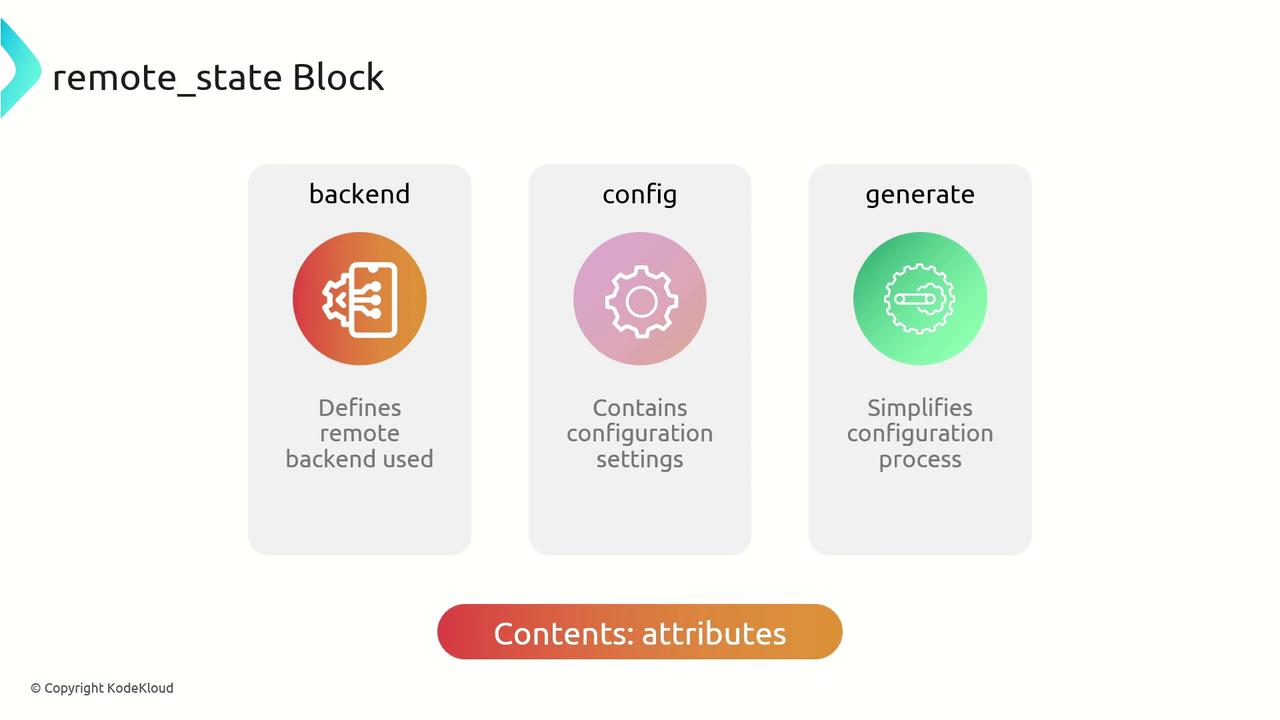Terragrunt for Beginners
Terragrunt Blocks
remote state Block
Terragrunt’s remote_state block centralizes Terraform state storage by configuring remote backends such as AWS S3, Azure Blob Storage, or Google Cloud Storage. This ensures consistency, locking, and encryption across multiple environments and teams.
By leveraging Terragrunt’s hierarchical configuration, you can inherit and override remote_state settings at various directory levels, simplifying the management of complex infrastructure setups.
remote_state Block Attributes

| Attribute | Description |
|---|---|
| backend | Type of Terraform remote backend (e.g., s3, azurerm). |
| config | Map of backend-specific settings: bucket names, storage accounts, encryption, etc. |
| generate | Optional. Auto-generates a Terraform backend file (e.g., backend.tf) following your conventions. |
Note
The generate block helps maintain a standard backend configuration across modules without manually creating backend.tf files.
Benefits of Using remote_state
| Benefit | Description |
|---|---|
| Centralized State | Stores all Terraform state in one place for easier collaboration and versioning. |
| Consistent Locking & Encryption | Utilizes backend features (e.g., DynamoDB locks for S3) to prevent concurrent changes. |
| Environment Isolation | Dynamic keys (e.g., path_relative_to_include()) separate state per module or layer. |
Security Considerations
- Enforce strict IAM policies to control who can read or modify state files.
- Enable server-side and transit encryption for sensitive data.
- Use locking mechanisms (e.g., DynamoDB for S3) to avoid race conditions.
Best Practices
- Apply a
remote_stateblock at the root of each environment for shared modules. - Leverage
generateto auto-create backend configuration and reduce manual errors. - Use dynamic paths like
path_relative_to_include()to isolate state per module.
Warning
Using generate.if_exists = "overwrite_terragrunt" will replace any existing backend file. Ensure you don’t lose custom modifications.
Example Configuration
The following example shows a complete remote_state block for an AWS S3 backend, including encryption, DynamoDB locking, and automatic backend file generation:
remote_state {
backend = "s3"
config = {
encrypt = true
bucket = "kodekloud-terragrunt-remote-state"
key = "${path_relative_to_include()}/terraform.tfstate"
region = "eu-west-1"
dynamodb_table = "terraform-locks"
}
generate = {
path = "backend.tf"
if_exists = "overwrite_terragrunt"
}
}
Breakdown of settings:
backend = "s3"
Selects the AWS S3 backend for remote state storage.config.encrypt = true
Enables server-side encryption on the S3 bucket.config.bucket
Specifies the S3 bucket name used for state files.config.key
Usespath_relative_to_include()to generate a unique path per module.config.region
Sets the AWS region (e.g.,eu-west-1).config.dynamodb_table
Defines a DynamoDB table for state locking and consistency.generate.path
Determines where to generate the Terraform backend file (e.g.,backend.tf).generate.if_exists
Controls behavior if the file already exists;overwrite_terragruntreplaces it.
By following this pattern, you achieve a secure, consistent, and maintainable remote state setup with Terragrunt.
Links and References
Watch Video
Watch video content